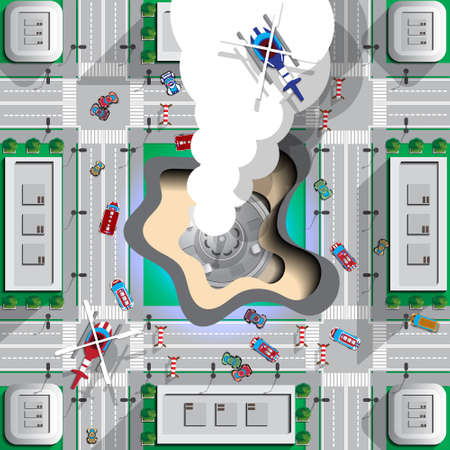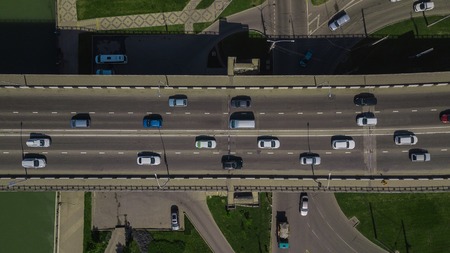Introduction: The Urban Traffic Challenge
Across the United States, urban traffic congestion is becoming an ever-growing challenge, impacting millions of commuters every day. As cities expand and populations rise, our roads are facing increased pressure, resulting in longer travel times, higher fuel consumption, and mounting frustration for drivers. But the consequences extend far beyond personal inconvenience. Traffic congestion contributes significantly to greenhouse gas emissions, worsening air quality and accelerating climate change. Economically, gridlocked streets cost Americans billions each year in lost productivity and wasted resources. Socially, prolonged commutes can undermine community well-being and reduce time spent with family or engaging in local activities. Addressing this complex issue requires innovative solutions that not only alleviate congestion but also promote sustainable urban growth—a task where artificial intelligence (AI) is beginning to make a meaningful difference.
AI-Driven Traffic Management Solutions
Across the United States, smart cities are turning to artificial intelligence as a game-changer for tackling traffic congestion. By integrating AI-powered traffic light systems, smart sensors, and predictive analytics, urban planners are reimagining how people move through city streets. These advanced technologies work together to monitor real-time conditions, adapt traffic signals on the fly, and forecast potential bottlenecks—making daily commutes smoother and more sustainable.
AI-Powered Traffic Light Systems
Traditional traffic lights operate on fixed timers that often fail to account for unexpected surges in vehicle or pedestrian flow. In contrast, AI-driven systems use cameras and sensors to collect live data about current road conditions. Machine learning algorithms then process this data to dynamically adjust signal timings based on actual traffic patterns. This reduces unnecessary idling, shortens wait times at intersections, and cuts down on fuel consumption—a win for both drivers and the environment.
Smart Sensors: The Eyes of the City
Smart sensors are being embedded in roads, traffic signals, and even public transit vehicles to continuously gather information such as vehicle count, speed, and congestion hotspots. This network of sensors allows city officials to detect accidents or roadblocks immediately and reroute vehicles as needed. The result? Less gridlock and improved response times during emergencies.
Predictive Analytics for Proactive Management
Another powerful tool in the AI toolbox is predictive analytics. By analyzing historical data along with current trends—like weather changes or special events—AI can forecast where congestion is likely to occur before it becomes a problem. This enables city agencies to proactively deploy resources or adjust public transit schedules, minimizing delays for everyone.
Key Features of AI-Driven Traffic Management
| Feature | Description | Sustainability Impact |
|---|---|---|
| Adaptive Signal Control | Dynamically changes light cycles based on real-time flow | Reduces emissions from idling vehicles |
| Integrated Smart Sensors | Monitors vehicle counts, speeds, and incidents | Improves safety and reduces congestion hotspots |
| Predictive Analytics | Forecasts potential congestion using big data | Enables proactive resource deployment and smooth traffic flow |
Towards Greener Urban Mobility
The adoption of these AI-driven solutions signals a shift towards greener, more efficient cities. With smarter traffic management, American communities can reduce their carbon footprint while making everyday travel more reliable for residents—a crucial step in building sustainable urban environments for future generations.

3. Real-Time Data and Adaptive Routing
In today’s smart cities, the integration of real-time data collected from connected vehicles, GPS-enabled smartphones, and traffic apps is revolutionizing how we tackle congestion. By leveraging artificial intelligence, these sources feed a constant stream of information into advanced traffic management systems. AI algorithms analyze this live data to identify emerging bottlenecks, unexpected slowdowns, and high-traffic zones as they happen. This dynamic understanding allows for adaptive routing—AI-powered systems can instantly suggest alternate routes to drivers through navigation apps or even update digital road signs in real time. Such proactive rerouting helps disperse traffic more evenly across city streets, minimizing gridlocks and reducing travel times. Not only does this reduce stress for daily commuters, but it also contributes to sustainability by cutting idle times and lowering vehicle emissions. This forward-thinking use of technology reflects a growing trend in American urban planning: putting data and AI at the heart of creating greener, more efficient communities.
Eco-Friendly Transportation and Emissions Reduction
As American cities strive to create a cleaner, more sustainable future, artificial intelligence (AI) is becoming a key ally in the fight against traffic congestion and vehicle emissions. By leveraging cutting-edge data analysis and real-time monitoring, AI-powered solutions make urban mobility not just smarter, but also greener. Here’s how AI-driven technology is transforming eco-friendly transportation:
Minimizing Idling and Smoothing Traffic Flow
Idling vehicles are a major source of unnecessary emissions in urban areas. AI algorithms optimize traffic signals and adjust timing based on actual demand, helping drivers spend less time at stoplights and reducing harmful pollutants. In places like Los Angeles and Seattle, smart traffic systems have already demonstrated significant drops in idle times, leading to measurable air quality improvements.
| AI Feature | Environmental Benefit |
|---|---|
| Adaptive Traffic Lights | Shorter wait times, reduced emissions from idling |
| Real-Time Congestion Monitoring | Smoother flow, fewer stop-and-go scenarios |
| Predictive Routing for Drivers | Avoidance of high-emission bottlenecks |
Supporting Electric Vehicle (EV) Infrastructure
Electric vehicles are a cornerstone of America’s clean transportation future. AI assists city planners by analyzing patterns in EV usage and recommending optimal locations for charging stations. This ensures that charging infrastructure keeps pace with the growing number of electric cars on the road, making it easier for drivers to go green without worrying about range anxiety.
Smart Integration for Greener Mobility
The combination of optimized traffic management and robust EV support forms the backbone of eco-friendly urban mobility. With AI in the driver’s seat, U.S. cities can look forward to less gridlock, cleaner air, and a smoother path toward their sustainability goals.
5. Case Studies: American Smart Cities Leading the Way
Across the United States, several pioneering cities are embracing artificial intelligence to tackle traffic congestion and advance their sustainability goals. These real-world examples illustrate how smart technology is driving positive change in urban mobility.
Los Angeles: Smarter Traffic Signals for a Greener City
Los Angeles, infamous for its gridlocked freeways, has taken significant steps toward smarter transportation management. The city’s Automated Traffic Surveillance and Control (ATSAC) system uses AI-powered sensors and adaptive algorithms to monitor traffic flow in real-time. By adjusting signal timings dynamically based on current conditions, LA has reduced average travel times and cut vehicle idling, which directly lowers greenhouse gas emissions. This innovative approach not only eases congestion but also supports the city’s ambitious climate action plan by promoting cleaner air and more efficient energy use.
New York City: AI in Action for a Sustainable Urban Core
New York City has long faced challenges with dense traffic and limited road space. The Department of Transportation has implemented AI-driven tools such as computer vision cameras and machine learning models to predict congestion hotspots and optimize routes for public transit and emergency vehicles. Additionally, NYC’s congestion pricing pilot leverages AI analytics to determine pricing structures that discourage unnecessary trips into high-traffic areas. Early results show reductions in peak-hour gridlock and increased use of sustainable transport modes like biking, walking, and mass transit—contributing to both improved mobility and lower carbon footprints.
Other Forward-Thinking U.S. Cities
Beyond the coasts, cities like Austin, Texas and Columbus, Ohio are integrating AI with connected vehicle technology, smart parking systems, and real-time public transportation updates. These efforts empower commuters to make informed choices, reduce time spent searching for parking or stuck in traffic, and encourage greener travel behaviors.
A Blueprint for Nationwide Change
The successes seen in Los Angeles, New York, and other American smart cities offer valuable lessons for urban planners across the country. By investing in AI-driven infrastructure now, communities can achieve smoother traffic flow, better air quality, and a more sustainable future—demonstrating that technology and environmental stewardship truly go hand-in-hand.
6. Challenges and Future Outlook
While AI-powered solutions are transforming the way smart cities manage traffic congestion, several challenges must be addressed to ensure a truly sustainable and inclusive future.
Privacy Concerns in the Age of Smart Mobility
AI-driven traffic management systems often rely on collecting vast amounts of data from sensors, cameras, and even individual smartphones. This raises valid concerns about personal privacy and data security. Cities must prioritize transparent data policies, robust encryption, and clear opt-in mechanisms to build public trust and protect residents’ rights.
Equity and Access for All Communities
Another key challenge is ensuring that the benefits of AI-enhanced mobility are distributed equitably across all neighborhoods. Historically underserved communities may lack access to smart infrastructure or face barriers to adopting new technologies. Urban planners and policymakers should engage diverse stakeholders, invest in bridging digital divides, and design mobility solutions that are accessible, affordable, and inclusive for everyone.
Building Resilient Tech Infrastructure
Effective AI-powered traffic management depends on reliable digital infrastructure—including high-speed connectivity, robust sensor networks, and real-time analytics platforms. Many American cities face aging infrastructure or funding gaps that can slow down adoption. Public-private partnerships and federal investment will play vital roles in scaling up smart city technologies nationwide.
The Road Ahead: Toward Climate-Friendly Urban Mobility
Looking forward, next-gen AI systems will do more than just reduce congestion—they’ll help cities meet climate goals by optimizing routes for electric vehicles, integrating public transit with shared mobility options, and reducing overall emissions. By addressing privacy, equity, and infrastructure challenges head-on, cities across the U.S. can unlock the full potential of AI to create cleaner, safer, and more connected urban environments for generations to come.

